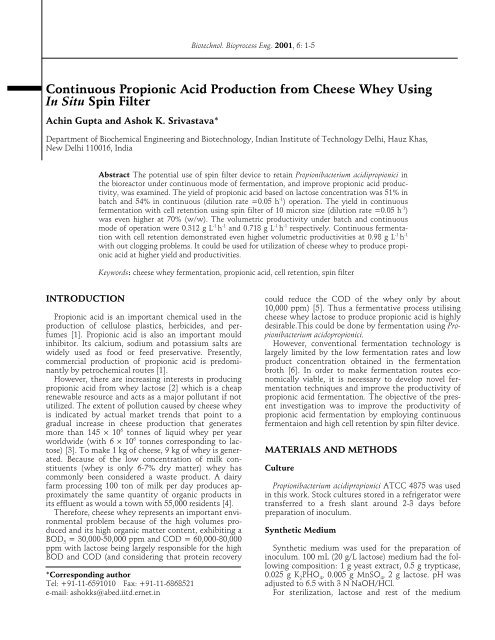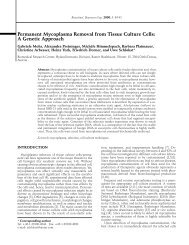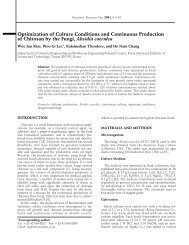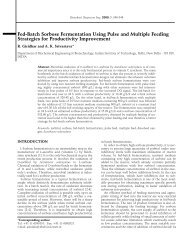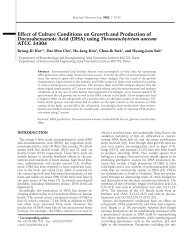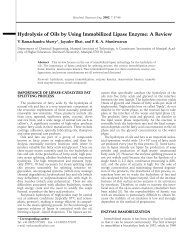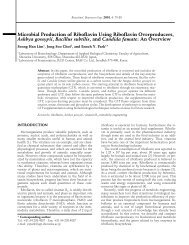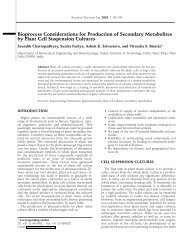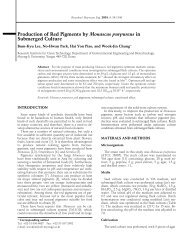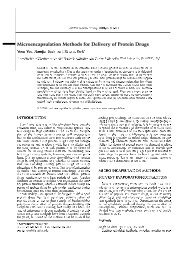Continuous Propionic Acid Production from Cheese Whey Using In ...
Continuous Propionic Acid Production from Cheese Whey Using In ...
Continuous Propionic Acid Production from Cheese Whey Using In ...
Create successful ePaper yourself
Turn your PDF publications into a flip-book with our unique Google optimized e-Paper software.
Biotechnol. Bioprocess Eng. 2001, 6: 1-5<br />
<strong>Continuous</strong> <strong>Propionic</strong> <strong>Acid</strong> <strong>Production</strong> <strong>from</strong> <strong>Cheese</strong> <strong>Whey</strong> <strong>Using</strong><br />
<strong>In</strong> Situ Spin Filter<br />
Achin Gupta and Ashok K. Srivastava*<br />
Department of Biochemical Engineering and Biotechnology, <strong>In</strong>dian <strong>In</strong>stitute of Technology Delhi, Hauz Khas,<br />
New Delhi 110016, <strong>In</strong>dia<br />
INTRODUCTION<br />
Abstract The potential use of spin filter device to retain Propionibacterium acidipropionici in<br />
the bioreactor under continuous mode of fermentation, and improve propionic acid productivity,<br />
was examined. The yield of propionic acid based on lactose concentration was 51% in<br />
batch and 54% in continuous (dilution rate =0.05 h -1 ) operation. The yield in continuous<br />
fermentation with cell retention using spin filter of 10 micron size (dilution rate =0.05 h -1 )<br />
was even higher at 70% (w/w). The volumetric productivity under batch and continuous<br />
mode of operation were 0.312 g L -1 h -1 and 0.718 g L -1 h -1 respectively. <strong>Continuous</strong> fermentation<br />
with cell retention demonstrated even higher volumetric productivities at 0.98 g L -1 h -1<br />
with out clogging problems. It could be used for utilization of cheese whey to produce propionic<br />
acid at higher yield and productivities.<br />
Keywords: cheese whey fermentation, propionic acid, cell retention, spin filter<br />
<strong>Propionic</strong> acid is an important chemical used in the<br />
production of cellulose plastics, herbicides, and perfumes<br />
[1]. <strong>Propionic</strong> acid is also an important mould<br />
inhibitor. Its calcium, sodium and potassium salts are<br />
widely used as food or feed preservative. Presently,<br />
commercial production of propionic acid is predominantly<br />
by petrochemical routes [1].<br />
However, there are increasing interests in producing<br />
propionic acid <strong>from</strong> whey lactose [2] which is a cheap<br />
renewable resource and acts as a major pollutant if not<br />
utilized. The extent of pollution caused by cheese whey<br />
is indicated by actual market trends that point to a<br />
gradual increase in cheese production that generates<br />
more than 145 × 10 6 tonnes of liquid whey per year<br />
worldwide (with 6 × 10 6 tonnes corresponding to lactose)<br />
[3]. To make 1 kg of cheese, 9 kg of whey is generated.<br />
Because of the low concentration of milk constituents<br />
(whey is only 6-7% dry matter) whey has<br />
commonly been considered a waste product. A dairy<br />
farm processing 100 ton of milk per day produces approximately<br />
the same quantity of organic products in<br />
its effluent as would a town with 55,000 residents [4].<br />
Therefore, cheese whey represents an important environmental<br />
problem because of the high volumes produced<br />
and its high organic matter content, exhibiting a<br />
BOD 5 = 30,000-50,000 ppm and COD = 60,000-80,000<br />
ppm with lactose being largely responsible for the high<br />
BOD and COD (and considering that protein recovery<br />
*Corresponding author<br />
Tel: +91-11-6591010 Fax: +91-11-6868521<br />
e-mail: ashokks@abed.iitd.ernet.in<br />
could reduce the COD of the whey only by about<br />
10,000 ppm) [5]. Thus a fermentative process utilising<br />
cheese whey lactose to produce propionic acid is highly<br />
desirable.This could be done by fermentation using Propionibacterium<br />
acidopropionici.<br />
However, conventional fermentation technology is<br />
largely limited by the low fermentation rates and low<br />
product concentration obtained in the fermentation<br />
broth [6]. <strong>In</strong> order to make fermentation routes economically<br />
viable, it is necessary to develop novel fermentation<br />
techniques and improve the productivity of<br />
propionic acid fermentation. The objective of the present<br />
investigation was to improve the productivity of<br />
propionic acid fermentation by employing continuous<br />
fermentaion and high cell retention by spin filter device.<br />
MATERIALS AND METHODS<br />
Culture<br />
Propionibacterium acidipropionici ATCC 4875 was used<br />
in this work. Stock cultures stored in a refrigerator were<br />
transferred to a fresh slant around 2-3 days before<br />
preparation of inoculum.<br />
Synthetic Medium<br />
Synthetic medium was used for the preparation of<br />
inoculum. 100 mL (20 g/L lactose) medium had the following<br />
composition: 1 g yeast extract, 0.5 g trypticase,<br />
0.025 g K 2 PHO 4 , 0.005 g MnSO 4 , 2 g lactose. pH was<br />
adjusted to 6.5 with 3 N NaOH/HCl.<br />
For sterilization, lactose and rest of the medium
2 Biotechnol. Bioprocess Eng. 2001, Vol. 6, No. 1<br />
components (basal medium) were autoclaved separately<br />
at 121 o C and 15 psig for 20 min. These were then mixed<br />
aseptically under laminar flow.<br />
Preparation of <strong>In</strong>oculum<br />
Twenty mililiter of synthetic medium was taken in a<br />
100 mL serum bottle, which was capped by a rubber<br />
stopper and sealed by aluminium cap by crimper. <strong>In</strong>oculation<br />
was done using a two days old slant scrapped in<br />
1 mL sterile distilled water. A uniform suspension was<br />
made in the water before transferring the inoculum to<br />
the serum bottle with the help of a sterile syringe. Before<br />
inoculation, N 2 was sparged through the serum<br />
bottle for about 15 min. An exit valve with sterile filter<br />
was provided at the outlet to prevent build up of excessive<br />
pressure. Growth was carried out at 30 o C in a<br />
shaker (Adolf Kuhner AG, Basel, Switzerland) maintained<br />
at 150 rpm. Sterile syringes were used to withdraw<br />
samples. Transfer of inoculum was done at<br />
around 40 h and 6% (v/v) inoculum was used.<br />
<strong>Cheese</strong> <strong>Whey</strong><br />
<strong>Cheese</strong> whey used for this work was obtained fresh<br />
<strong>from</strong> NIRULA’S cheese manufacturing unit Noida, Uttar<br />
Pradesh, <strong>In</strong>dia. When fresh, it contained 30 to 35 g/L<br />
lactose. <strong>Cheese</strong> whey was stored in cold room at around<br />
5 o C and was used within 1 to 2 weeks of procurement.<br />
<strong>Whey</strong> Treatment<br />
This involved autoclaving of cheese whey at different<br />
pH values i.e., 3.5, 4.0 and 4.5. As all of these gave large<br />
amounts of precipitates, the decanted cheese whey was<br />
tried out as a growth medium. The whey thus obtained<br />
was clear enough to be used for OD determination. Nutrient<br />
supplementation was done with yeast extract to<br />
a final concentration of 2% (w/v) and pH adjusted to<br />
6.5 before inoculation. It was observed that there were<br />
no suspended particles after above pH and Temperature<br />
treatment of whey, however, any minor deviation <strong>from</strong><br />
this, was accounted for when results were analysed<br />
along with the product analysis profiles. High product<br />
profile (which was accurately estimated by HPLC) and<br />
not biomass was the ultimate objective of entire experimentation.<br />
Shake Flask Studies<br />
For shake flask studies 500-mL flasks were modified<br />
by glass blowing so that it can be closed by rubber<br />
stopper and sealed by aluminium caps using crimper.<br />
<strong>Cheese</strong> whey was autoclaved in a normal flask and<br />
yeast extract was autoclaved in the modified shake<br />
flask. After autoclaving, the cheese whey liquid was<br />
decanted under sterile conditions by transfering it into<br />
the flask containing yeast extract. This was then inoculated<br />
with 6% inoculum. Nitrogen gas was then sparged<br />
through the flask for 15 min to create anaerobic condi-<br />
tions. An exit valve through sterile filter was provided<br />
to prevent build up of excessive pressure during<br />
sparging of nitrogen.<br />
Growth was carried out at 30 o C and 150 rpm. Samples<br />
were withdrawn at regular intervals using sterile<br />
syringes, pH was maintained between 6 and 7 during<br />
growth by intermittant addition of sterile 3 N NaOH.<br />
Fermenter<br />
Fermentation studies were carried out in a Bioengineering<br />
AG, 6-L fermentor with four baffles and<br />
equipped with two set of 70 mm diameter disc turbine<br />
impellors. The fermentor had a total capacity of 6 L.<br />
The fermentation was carried out with a working volume<br />
of 4.5 L. The medium used for fermentation was<br />
cheese whey supplemented with 2% yeast extract. For<br />
preparation of 4.5 L medium, 90 g of yeast extract<br />
powder was dissolved in 500 mL distilled water and<br />
added to 4 L of cheese whey (duly decanted) after autoclaving<br />
under sterile conditions.<br />
Assay Methods<br />
Biomass Estimation<br />
Cell concentration in fermentation broth was monitored<br />
by measuring the optical density at 660 nm<br />
(OD 660 ) of the suspension in a 1.5 mL polystyrene cuvette<br />
in a Beckman Model 24 spectrophotometer. An<br />
optical density vs. cell concentration plot was prepared<br />
and it was found that one unit of optical density was<br />
equivalent of 0.42 g/L of cells.<br />
Substrate/Product Estimations <strong>Using</strong> HPLC<br />
High performance liquid chromatography (HPLC)<br />
was used to assay the samples <strong>from</strong> fermentation experiments<br />
for lactose, propionic and acetic acid concentrations.<br />
The column used was organic acid analysis<br />
column (Model HPX-87H, Bio-Rad, USA). The temperature<br />
of column was kept at 58 o C. Mobile phase<br />
used was 0.01 N H 2 SO 4 at a flow rate of 0.6 mL/min.<br />
The detector used was an refractive index (RI) detector<br />
(410 Differential Refractometer, Waters, USA).<br />
All the fermentation samples were centrifuged at<br />
12,000 rpm for 20 min and made cell free. Before injection<br />
each sample had to be filtered using a 0.45 µm disposable<br />
filter.<br />
Batch Fermentation<br />
Batch experiments were carried out in a 6-L fermentor<br />
with a working volume of 4.5 L. Fermentation medium<br />
had the composition described above. The fermentor<br />
was autoclaved with distilled water, in situ. After<br />
autoclaving, when the temperature dropped down<br />
to 60 o C, the water was removed through the sampling<br />
port by exerting N 2 pressure. Subsequently, cheese<br />
whey and yeast extract were added aseptically using a<br />
high speed pump (Watson Marlow, England).
Biotechnol. Bioprocess Eng. 2001, Vol. 6, No. 1 3<br />
Forty hours old inoculum was used, the headspace of<br />
fermentor was flushed with N 2 to maintain anaerobiosis<br />
in the fermentor. The pH was maintained at 6.5 and<br />
temperature at 30 o C throughout the course of fermentation<br />
using 6 M NaOH solution. Agitator was kept at<br />
150 rpm. Ten mililiter liquid samples were collected at<br />
regular intervals and analysed for the biomass and<br />
product concentrations.<br />
<strong>Continuous</strong> Fermentation<br />
Experiment was started as a batch with a working<br />
volume of 4.5 L, pH 6.5, temperature 30 o C and agitation<br />
150 rpm. After 36 h, continuous nutrient feeding (at<br />
dilution rate of 0.05 h -1 ) was started and simultaneously<br />
an outlet was provided with the same flow rate so as to<br />
maintain the constant reactor level. Fifty mililiter samples<br />
were collected <strong>from</strong> outlet port at regular intervals.<br />
Fermentation was continued till 3 reactor volumes had<br />
been passed, in order to attain a steady state.<br />
<strong>Continuous</strong> Fermentation with Cell Retention<br />
Operation was similar to continuous fermentation<br />
with the exception that cells were retained within the<br />
bioreactor while fresh medium was continuously supplied<br />
and spent cell-free medium with product was removed.<br />
For this purpose, one of the simplest perfusion<br />
systems - the spinfilter device (as shown in Fig. 1) was<br />
used. A practical advantage of this was that it could be<br />
incorporated into the existing bioreactor. This was a<br />
cylindrical filter (85 mm internal diameter and 165 mm<br />
height) with a solid bottom which was mounted on the<br />
stirrer shaft in the bioreactor. Fresh medium was added<br />
in the bioreactor outside the spinfilter while spent medium,<br />
duly filtered, was withdrawn <strong>from</strong> within the<br />
rotating porous filter. The device was highly instrumental<br />
in retaining the microorganisms inside the bioreactor<br />
and filtered fermentation broth only was allowed<br />
to leave out of the reactor. The filter had a stainless<br />
steel-mesh with pore size of 10 µm and therefore, it<br />
could only partially retain the cells in the reactor. The<br />
dilution rate was kept at 0.05 h -1 and the process was<br />
continued till 4 reactor volumes had been passed.<br />
RESULTS AND DISCUSSION<br />
Shake Flask Fermentations<br />
Growth of Propionibacterium acidipropionici (in serum<br />
bottles and modified shake flask) was attempted in single/double<br />
autoclaved cheese whey solution and with<br />
cheese whey supplemented with 2% yeast extract. It<br />
was found that no growth was observed in cheese whey<br />
solution which was autoclaved twice probably due to<br />
the toxic effect of certain substances emerged during<br />
double autoclaving of medium. No growth in<br />
Fig. 1. Schematic representation of continuous fermentation<br />
with in situ cell retention using spin filter.<br />
double autoclaved medium was observed by other investigators<br />
also [7].<br />
It was also observed that shake flask fermentation<br />
with 50 mL volume using plain cheese whey as substrate<br />
and not supplemented with any yeast extract did<br />
not show any growth even after 3 days. It appears that<br />
yeast extract serves to replace nutrients destroyed during<br />
autoclaving (such as vitamins, amino acids and sugars)<br />
directly or inhibit reactions leading to nutrient loss,<br />
the effect being more pronounced at higher yeast extract<br />
concentrations. Secondly, inhibitory compounds<br />
were formed when the whey was autoclaved. The yeast<br />
extract might be reducing the formation of inhibitory<br />
compounds or rendering them less inhibitory, i.e., binding<br />
with the inhibitor [7]. For all future work, yeast<br />
extract concentration was kept at 2% (w/v). OD vs. cell<br />
concentration curve was prepared. It demonstrated a<br />
linear relationship below OD 0.45. 1 unit of OD was<br />
found to be equivalent to 0.42 g/L cells.<br />
A maximum propionic acid of 7.6 g/L was obtained<br />
in the shake flask fermentation. As expected this was<br />
lower as compared to concentrations reported <strong>from</strong> the<br />
work on the synthetic medium using the fermenter [8].<br />
Batch Fermentation<br />
Fig. 2 shows typical concentration profiles of lactose,<br />
biomass, propionic and acetic acid at pH 6.0 and 30 o C<br />
under anaerobic conditions in a batch fermentor. The<br />
whey used as fermentation medium was supplemented<br />
with yeast extract to a final concentration of 2% (w/v).<br />
This was essential because as reported earlier [9], plain<br />
whey permeate was not a good substrate for conventional<br />
batch propionic acid fermentation.<br />
Good growth was observed under these conditions<br />
and biomass concentration reached a high of 10.5 g/L<br />
after 45 h. At the same time, lactose concentration
4 Biotechnol. Bioprocess Eng. 2001, Vol. 6, No. 1<br />
Fig. 2. Batch fermentation kinetics for cheese whey fermentation.<br />
Fig. 3. Variation of product formation rate with specific<br />
growth rate for batch cheese whey fermentation.<br />
dropped down <strong>from</strong> around 30.5 g/L to 0.8 g/L. A lag<br />
phase extending upto 12 h was seen and no significant<br />
product formation occurred during this time. <strong>Propionic</strong><br />
acid formation was mainly associated with growth,<br />
which is evident <strong>from</strong> the fact that between 12 and 35<br />
h, as cell concentration increased <strong>from</strong> 1 g/L to around<br />
9 g/L, propionic acid concentration increased <strong>from</strong> zero<br />
to 11.5 g/L. <strong>Propionic</strong> acid concentration kept on increasing<br />
even after the cells reached a stationary phase.<br />
This shows that its production is related not only to<br />
the growth of cells, but also to the concentration of<br />
cells. <strong>Propionic</strong> acid concentration reached a final value<br />
of 15.7 g/L. The yield of propionic acid calculated per<br />
gram of lactose consumed was found out to be 51%<br />
(w/w). This is comparable to the maximum yield obtained<br />
<strong>from</strong> growth on synthetic medium [6,8] and<br />
much higher than those reported for work on cheese<br />
whey [9]. The volumetric productivity of propionic<br />
acid, calculated after 50 h, comes out to be 0.31 gL -1 h -1<br />
which is nearly 7 times that reported for earlier work on<br />
simple batch fermentation of whey permeate [10].<br />
<strong>Continuous</strong> Fermentation<br />
From the batch fermentation data, a plot of specific<br />
growth rate vs. the product formation rate was prepared<br />
as shown in Fig. 3. The plot indicated a maximum<br />
propionic acid formation rate at around 0.05 h -1<br />
value of specific growth rate. It was, therefore, decided<br />
Fig. 4. <strong>Continuous</strong> fermentation kinetics (Dilution rate D =<br />
0.05 h -1 ) for cheese whey fermentation.<br />
to perform a continuous fermentation with a specific<br />
growth rate of 0.05 h -1 and for this purpose the dilution<br />
rate (feed rate/reactor volume) was kept at 0.05 h -1 . For<br />
the initial 36 h, reactor was operated under batch conditions<br />
as described in previous section, and feed was<br />
started thereafter.<br />
The data for fermentation are shown in Fig. 4. At the<br />
start of feeding lactose concentration was 8.1 g/L which<br />
dropped down to 1.25 g/L after just 4 h. Thereafter it<br />
came to a steady level of approximately 0.5 g/L after 40<br />
h of continuous feed. The cell concentration came to a<br />
steady state of 11.5 g/L. The continuous fermentation<br />
was conducted till three reactor volumes (13.5 L) of the<br />
media had passed.<br />
The propionic acid concentration reached a steady<br />
state value of 14.5 g/L. Acetic acid concentration stabilised<br />
at 6.6 g/L. <strong>Propionic</strong> acid yield based on lactose<br />
consumption at steady state in the continuous mode<br />
was 54% (w/w) which was marginally higher than the<br />
51% yield obtained in case of batch fermentation. But<br />
the volumetric productivity of propionic acid showed<br />
130% increase over batch productivity, which were<br />
0.312 g L -1 h -1 in batch fermentation & 0.715 g L -1 h -1 in<br />
continuous fermentation. This compared to previously<br />
reported productivity values of 0.045 g L -1 h -1 for batch<br />
fermentation of whey permeate [10], This was a 15 fold<br />
increase in the productivity of continuous fermentation.<br />
Also, it was only slightly less than the maximum<br />
productivity obtained in continuous fermentation on<br />
cheese whey in a fibrous bed bioreactor with immobilized<br />
cells, where the productivity ranged <strong>from</strong> 0.35 to<br />
0.78 g L -1 h -1 [10]. However, the yield of propionic acid<br />
based on lactose was same in both the cases at 54%<br />
(w/w).<br />
<strong>Continuous</strong> Fermentation with Cell Retention<br />
For continuous fermentation with cell retention, after<br />
40.5 h of batch operation, fresh medium was continuously<br />
supplied while spent cell free medium, along<br />
with product, was removed. The dilution rate was kept<br />
as 0.05 h -1 , which was same as that for continuous fermentation,<br />
in order to enable comparison of the two.<br />
The data for the fermentation is shown in Fig. 5. As
Biotechnol. Bioprocess Eng. 2001, Vol. 6, No. 1 5<br />
Fig. 5. <strong>Continuous</strong> fermentation kinetics with in situ cell retention<br />
by 10 micron spin filter (Dilution rate D = 0.05 h -1 )<br />
for cheese whey fermentation.<br />
is clear <strong>from</strong> the graph, the cell concentration in continuous<br />
mode demonstrated an increase between 70 to<br />
80 h, but stabilized thereafter up to 120 h. This might<br />
be due to the fact that on prolonged operation, the cells<br />
deposit on the pores of the rotary spin filter and<br />
thereby reduce the effective pore size of the filter thus<br />
leading to less passage of cells. This, eventually, resulted<br />
in an increase in the cell concentration inside the reactor<br />
and the cell concentration at the end of 120 h<br />
reached a steady value of 15 g/L. This was higher than<br />
the 11.5 g/L achieved in continuous fermentation at<br />
same dilution rate D = 0.05 h -1 . Lactose concentration<br />
in the fermentor reduced to a steady state value of approximately<br />
1 g/L.<br />
The trend of propionic acid concentration demonstrated<br />
a gradual increase throughout the batch growth<br />
phase. At the start of continuous phase of fermentation<br />
it reached a value of about 14.5 g/L and kept on increasing<br />
slightly up to 85 h, after which it indicated a jump<br />
to 19.7 g/L within the next 15 h and then levelled off at<br />
this value upto 120 h. This reflected a rise in propionic<br />
acid concentration corresponding to the rise in cell concentration.<br />
The yield of propionic acid in this case was 70%<br />
(w/w) which was much higher than that for continuous<br />
operation (54%). This indicated that higher cell<br />
concentration, resulted in increased propionic acid fermentation.<br />
The volumetric productivity also showed a<br />
significant increase over continuous fermentation and<br />
at steady state, it was 0.98 g L -1 h -1 .<br />
CONCLUSION<br />
Different fermentations conducted in both batch and<br />
continuous mode of operation confirmed that good<br />
growth can be achieved with cheese whey as medium<br />
to produce propionic acid. Partial removal of suspended<br />
particles in cheese whey could be done by autoclaving<br />
and decantation under sterile conditions. Yeast extract<br />
supplementation (2% w/v) was necessary for good<br />
growth. Growth carried out on this medium at 30 o C,<br />
pH 6.5 and anaerobic conditions shows good propionic<br />
acid production under different modes of reactor operation.<br />
The yield of propionic acid based on lactose concentration<br />
was 51% in batch and 54% in continuous operation<br />
The yield in continuous with cell retention was<br />
even higher at 70% (w/w). The volumetric productivity<br />
under batch conditions was 0.312 g L -1 h -1 . <strong>Continuous</strong><br />
fermentation and continuous fermentation with cell<br />
retention demonstrated even higher volumetric productivities<br />
values of 0.715 g L -1 h -1 . and 0.98 g L -1 h -1 respectively.<br />
REFERENCES<br />
[1] Playne, M. J. (1985) <strong>Propionic</strong> and butyric acids. pp. 731,<br />
<strong>In</strong>: M. Moo- Young (ed.), Comprehensive Biotechnology,<br />
Volume 3, Pergamon, NY, USA.<br />
[2] Lewis, V. P. and S. T. Yang (1992a) <strong>Continuous</strong> propionic<br />
acid fermentation by immobilized Propionibacterium<br />
acidipropionici in a novel packed-bed bioreactor, Biotechnol.<br />
Bioeng. 40: 465-474.<br />
[3] Castillo, F. J. (1990) Lactose metabolism by yeasts. pp<br />
297-320. <strong>In</strong>: H. Verachtert and R. de Mot (eds.). Yeast<br />
Biotechnology and Biocatalysis, Marcel Dekker, NY, USA.<br />
[4] Siso, M. I. G. (1996) The biotechnological utilization of<br />
cheese whey: A review. Bioresource Technol. 57:1-11.<br />
[5] Mawson, A. J. (1988) Yeast biomass production <strong>from</strong><br />
acid whey permeate. Biotechnol. Lett. 10: 503-508.<br />
[6] Hsu, S. T. and S. T. Yang (1991) <strong>Propionic</strong> acid fermentation<br />
of lactose by Propionibacterium acidopropionici: Effect<br />
of pH. Biotechnol. Bioeng. 38: 571-578.<br />
[7] Anderson, T. M., E. A. Bodie, N. Goodman, and R. D.<br />
Schwartz (1986) <strong>In</strong>hibitory effect of autoclaving whey<br />
based medium on propionic acid production by Propionibacterium<br />
shermanii. Appl. Env. Microbiol. 51: 427-428.<br />
[8] Lewis, V. P. and S. T. Yang (1992) <strong>Propionic</strong> acid fermentation<br />
by Propionibacterium acidipropionici: Effect of<br />
growth substrate. Appl. Microbiol. Biotechnol. 37: 437-442.<br />
[9] Yang, S. T., H. Zhu, and Y. Li. (1994) <strong>Continuous</strong> propionate<br />
production <strong>from</strong> whey permeate using a novel fibrous<br />
bed reactor. Biotechnol. Bioeng. 43: 1124-1130.<br />
[10] Woskow, S. A. and B. A. Glatz (1991) <strong>Propionic</strong> acid production<br />
by a propionic acid-tolerant strain of Propionibacterium<br />
acidipropionici in batch and semicontinuous<br />
fermentation. Appl. Environ. Microbiol. 57: 2821- 2828.<br />
[Received November 28, 2000; accepted February 3, 2001]


